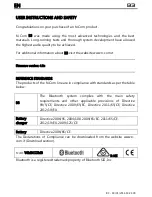
Preparing To Ride
4
Chapter 2
Personal safety and comfort are enhanced when you wear protective
clothing. Operating without protective clothing increases your chances of
severe injury in the event of an accident. Always wear an approved
motorcycle helmet that fits properly.
Although complete protection is not possible, knowing what to wear
and how to wear it can make you more comfortable when you ride and
reduce the chance of injury in case of a spill.
Dressing Like the Pros
Helmets
The single most important piece of protective gear you can wear is a
helmet. A good helmet can help prevent serious head injuries. Studies
have shown that wearing a helmet does not reduce essential vision or
hearing. Operating without an approved motorcycle helmet will increase
the chance of severe head injury to yourself in the event of an accident.
What to look for in a Helmet
Standards and Testing
Helmets protect your head in two ways: the outer shell resists pene-
tration and abrasion, and the inner liner absorbs shock by slowly col-
lapsing under impact. Both the shell and the liner essentially self-destruct
by spreading the forces of an impact throughout the helmet material. That
is why, in most cases, if a helmet has been damaged in an accident it may
be of little protective value in another mishap.
When you purchase a helmet, look for stickers inside or on the outside
of the helmet, confirming compliance with the standards: Australian
Standards - AS1698.
Each organisation has established procedures to evaluate
helmets for:
•
Impact - the shock absorbing capacity of the helmet.
•
Penetration - The ability of the helmet to withstand a blow from a
sharp object.
•
Retention - the ability of the chinstrap to stay fastened without break-
ing or stretching.
•
Peripheral Vision - the helmet must provide a minimum side vision of
120 degrees each side. (Most people’s peripheral vision is between
110 and 115 degrees.
The Right Helmet for You
While colour, design and price may influence your decision about
which helmet to buy, protection should be your first consideration.
The full-faced helmet provides the most protection since it covers more
of your face. Recent design improvements in shell material and interior
ventilation have improved comfort. The next choice in protection is the
three-quarter helmet. It does not offer the face and chin protection that
full-faced helmets do, so if you choose this style, it should be used with
mouth/chin protection.
For a helmet to offer the most protection possible it must fit properly.
Your helmet should fit snugly but comfortably and be securely fastened.
Always fasten you helmet’s chinstrap snugly. A helmet will do you no
good if it comes off during a mishap.
The Right Helmet for Youngsters
A helmet is also the most important piece of protective gear for chil-
dren. Athletic headgear such as hockey, football or skateboard helmets
ARE NOT ACCEPTABLE for ATV riding. They do not have adequate ener-
gy absorption qualities for use while operating a motorised vehicle.
As with any helmet, a child’s helmet must fit properly to be effective.
Do not use an adult-sized helmet that is too large for a youngster.
Helmets are available in Children’s sizes. Check with your ATV dealer.
Replacing Your Helmet
Plan to replace your helmet if it has been involved in an accident. Some
helmet manufacturers will inspect and, when possible, repair a damaged
helmet. If your helmet has been dropped, there may be damage that you
don’t see; you may want to take advantage of this service.
Most helmet manufacturers recommend that, under normal use, you
should replace your helmet every two to four years. If you notice any
signs of damage before then, replace it immediately. As mentioned
above, helmets may crack or break if dropped.
Why replace a helmet every few years if it does not appear damaged?
Its protective qualities may deteriorate over time. The interior padding
compresses, offering less protection. The chinstrap may fray or loosen at
its attaching points and the shell may be chipped or banged. Probably
the best reason, however, is the consistent improvement of design and
protective qualities of helmets.
Since 1980, all helmet manufacturers have been required to stamp the
month and date of production of the helmet. If you cannot remember
when you bought your present helmet, just check the production date. If
there is no date at all, you should definitely replace your helmet now.
Helmet care
Follow the manufacturer’s directions in caring for your helmet. Use only
the mildest soap recommended.
Avoid any petroleum-based cleaning fluids, especially if you own an
injection-molded plastic helmet. Exposure to strong cleaning agents can
cause the plastic helmet and its liners to decompose and lose protective
value.
In Short
There are many considerations when deciding which helmet to buy.
Talk with you local motorcycle and ATV dealer, and consult ATV enthusi-
ast magazines for information to help in you decision.
Full Face Helmet
Open Face Helmet
Knee guards
Boots
Helmet & Goggles
Chest & shoulder
protector
Off road pants
Gloves






































